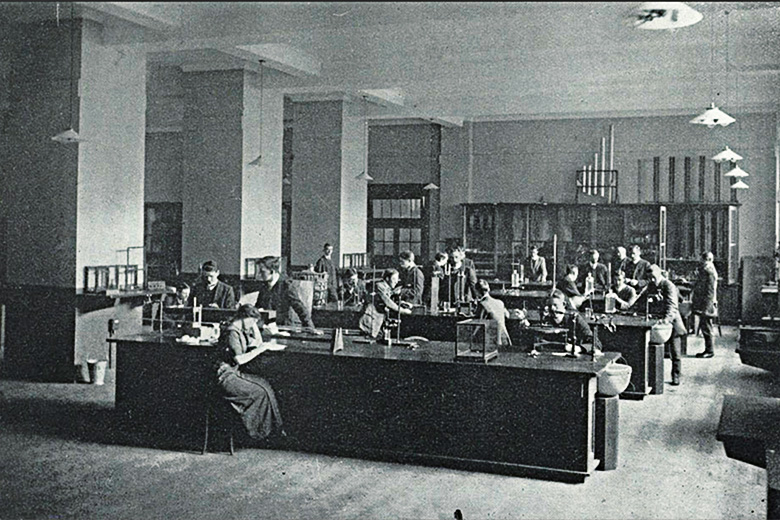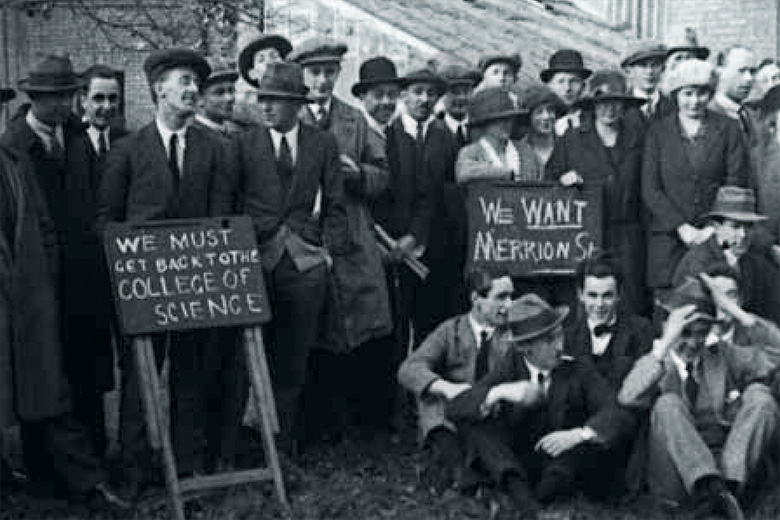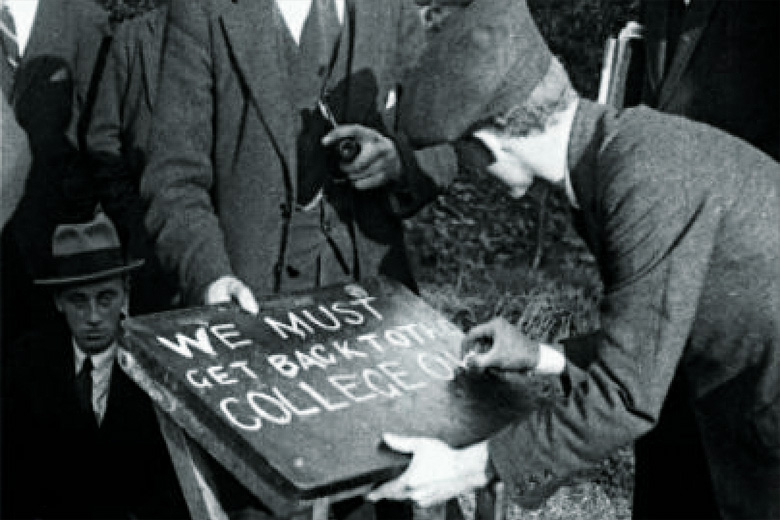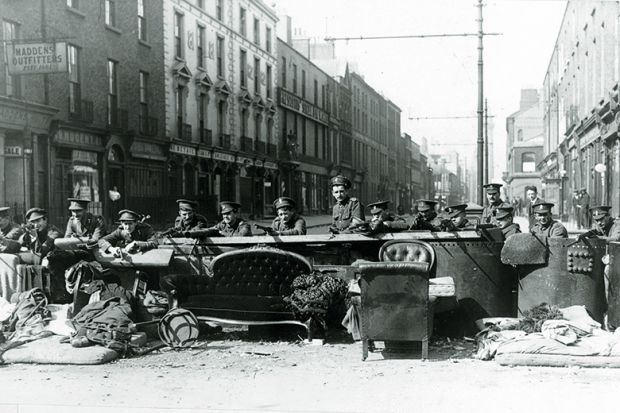It is no coincidence that the UK government is talking up the value of technical education at the same time as it is negotiating its departure from the European Union. The need for enhanced technical skills to help the country flourish after what Brexit supporters dub its independence from the EU has been recognised.
But independence movements have not always seen things quite this way. In particular, the Irish War of Independence against forces of the British Crown in the 1920s saw the demise of a now long-forgotten progressive experiment in technical education designed to kick-start science, education and industrial expertise on the island of Ireland. Amid fears that the possible post-Brexit return of customs checks on the Republic’s border with Northern Ireland could reopen dangerous political wounds, the story of the Royal College of Science for Ireland, which opened 150 years ago this month, also reminds us of the role that messy political and sectarian disputes played in shaping the development of higher education institutions in Ireland.
The college opened its doors in a leafy part of Dublin overlooking St Stephen’s Green on 4 November 1867, offering students from across the British Isles advanced courses in physics, chemistry, mining, engineering and other sciences. Its establishment came after a long campaign for a higher scientific institution in Ireland led by the eminent Irish chemist and educationalist Sir Robert Kane.
Kane was convinced that Ireland – even after the catastrophe of the Great Famine – was ripe for industrial development and resource extraction. To this end, in 1845, he established the Museum of Irish Industry, an institution that offered the artisan and middle classes formal lectures in the applied sciences, for a modest fee – as well as free public lectures. The museum was popular among Dubliners because it was non-denominational at a time when science education was dominated by the Protestant elite, and also because it permitted women to attend courses and sit exams.

In 1866, a government commission recommended that the museum be transformed into something grander: a state-funded institution with an increased number of professorships aimed at training the next generation of science teachers. This reflected the policy of bureaucrats at the UK’s Science and Art Department – a subdivision of the Board of Trade based at the same South Kensington site as the forerunner of the Victoria and Albert Museum. In an echo of the present, they feared that Great Britain and Ireland were badly lagging behind Germany and France in the provision of science and technical education.
The aim of the new institution was clear: “to supply, as far as practicable, a complete course of instruction in science applicable to the Industrial Arts, especially those which may be classed broadly under mining, agriculture, engineering, and manufactures, and to aid in the instruction of teachers for the local schools of science”.
Despite local disquiet at the demise of the Museum of Irish Industry, the foundation of the Royal College of Science for Ireland in the same building inspired the Irish Times to publish grandiose visions of a “University of Technical Education” that would stimulate native industries and manufacturers, and even “solve our agrarian questions”. But while such hopes were never realistic, the college was clearly on the right side of history in terms of its aspirations. Its problem was that it was ultimately on the wrong side of history in more political terms.
Its development was affected by the support given by South Kensington. Because the college was seen as a part of a centralised British science policy, staff had to work hard to sell the message of higher scientific instruction to the small section of the Irish middle class that could afford third-level education.
The difficulty of that sell is reflected in the low numbers of enrolments that the college received for many years (total student numbers remained below 100 until 1887), and by the fact that many of the people who did register to do its three-year diploma (it did not have degree-awarding powers) were English and Scottish scholarship students. This earned sneers from Irish nationalists, who wondered how science education was supposed to spread in Ireland if the locals did not enrol.
The administrators painted its low student numbers in the best light possible, arguing that a student-to-professor ratio of 7:2 compared favourably with other scientific institutions in Europe. And supporters of the project blamed its modest growth on the “backward” education system in Ireland and on the lack of job opportunities for graduates in a predominantly agrarian economy.
Either way, there are many reasons to celebrate the college’s establishment. It was innovative in offering practical courses and laboratory experience in the physical sciences at a time when this was not a common feature of established universities elsewhere in the UK. Its students were encouraged to participate in the industrial life of the city, and courses included visits to local manufacturers, gasworks and factories.
The college was also notably progressive in its hiring, giving opportunities to young and upwardly mobile professors to develop their reputations and advance their disciplines. Ramsay Traquair, for example, was 27 when he became professor of zoology in 1867; he left in 1873 to become the first keeper of natural history at the Edinburgh Museum of Science and Art. Alfred Cort Haddon, later a renowned anthropologist at the University of Cambridge, became professor of zoology in 1880 at the even younger age of 25. Long before his expedition to the Torres Strait Islands, Haddon was measuring heads on the Aran Islands off the west coast of Ireland during summer breaks from teaching.
But William Fletcher Barrett, who became professor of experimental physics in 1873, stands out as the most influential of the early appointments. Although he is better known today as one of the founders of the Society for Psychical Research in London in 1882, in his time Barrett was an important figure in the scientific and intellectual culture of Dublin. Indeed, by the time he retired in 1909, he had established modern physics teaching in Ireland.
Barrett came to Dublin imbued with South Kensington’s ethos of practical physics teaching as a means of extending scientific culture throughout the school system. He taught his students how to build their own simple apparatus, and, when he opened his physics laboratory in 1875, the college could boast that it was the best in Ireland – although a later report mentioned that the vibration of tram traffic around St Stephen’s Green “often had the tendency to interfere with the adjustment of scientific instruments”.
Another progressive element of the college was that, like its predecessor, it was open to women, many of whom went on to gain degrees from the Royal University of Ireland and the Royal College of Surgeons. Indeed, during his time at the college, Barrett lobbied for the extension of education for women and for female suffrage. The college also offered evening courses – taught voluntarily by the professors – that attracted hundreds of students each year.

By the 1890s, the Royal College of Science for Ireland had turned a corner. Student numbers began to increase – probably as a result of advances in general education. But this caused severe overcrowding and inconvenience to staff and students. The college buildings were also showing the strain. In his correspondence, Walter Noel Hartley, the institution’s professor of chemistry, complained at length about the chunks of ceiling that fell down as he lectured; the draughts that blew poisonous fumes into the faces of those at work; and the weakness of the cord lines to the “draught chambers” – presumably fume cupboards – such that once “a lady-student was as nearly as possible guillotined by the rapid descent of the sash”.
A new era for the college began in 1899, when the Dublin-based Department of Agriculture and Technical Instruction (DATI) took over the Irish institutions that had previously been run from South Kensington. It was reorganised along a polytechnic model, with agricultural and industrial service to the department itself prioritised. Yet this reorganisation merely exacerbated long-term problems regarding space and facilities, and it was a great relief to staff and students when, in the same year, a parliamentary committee recommended the construction of new buildings for both the college and the department on nearby Upper Merrion Street.
This magnificent complex, designed by the renowned architect Sir Aston Webb (who also designed the facade of Buckingham Palace) and fitted with elevators and electricity, was officially opened by King George V in 1911. It was the last major public works investment of the British government in Ireland before independence.
Despite the fact that the college was at last beginning to thrive, it is hard to avoid the conclusion that its new home played a role in its sudden demise. During the First World War, the engineering workshops were manned night and day for the construction of war munitions, while other parts of the premises were used as medical supply depots. As the Irish War of Independence, which broke out in 1919, came to a conclusion with the signing of the Anglo-Irish Treaty in late 1921, the college found itself in the administrative nerve centre of the new Irish Free State regime since its buildings backed on to Leinster House, where parliament sat.
In October 1922, in the midst of the civil war that broke out between Free State forces and Republicans opposed to the treaty, the college buildings were officially closed, and parts of them were taken over by the Free State government for use as offices. This action was taken following military intelligence of a Republican bomb plot, allegedly confirmed by the discovery of a device in the college. However, a staff member claimed that this “was simply an aeroplane dynamo for demonstration purposes”.
Staff and students were scattered to other locations, losing access to their laboratories and workshops. They doubted the military reasoning behind the closure and feared that it was a permanent eviction. British Pathé footage at the time shows more than 100 well-dressed and jovial men and women protesting in Dublin, flicking cigarette butts at each other and holding up signs reading “We want Merrion St” and “We must get back to the College of Science”.
A lobbying effort was launched to save the college (now shorn of its “Royal” prefix). An article in Nature argued that its loss would be a “national calamity” for the new state; and one commentator pointed to the “spirit of harmony” that always existed in a student body where northerner and southerner, Home Ruler and Unionist, commingled freely.
Despite this, the Free State’s minister for education, Eoin MacNeill, was only too glad to use the political situation to establish his alma mater, University College Dublin, as the new nation’s pre-eminent scientific institution. The University Education Act of 1926 amalgamated the college with UCD, allowing the college’s former premises on Upper Merrion Street to become Government Buildings, which still houses several departments of the Irish government to this day.

The policymakers and bureaucrats of the Free State shed no tears over the college’s closure, because they tended to be teachers, clerks, civil servants, farmers or professionals from the liberal arts or medical sciences. This is indicative of the fact that the college, focused on the physical sciences, simply never established strong enough roots across Irish society, particularly among the Catholic and nationalist middle class.
But Ireland’s lack of an industrial base also counted against the institution’s survival. Although it made sense as part of a wider UK science policy, the college could fulfil its potential only in the service of either an industrialising nation or, as in Denmark, a nation with leaders willing and able to consistently modernise its agricultural sector. DATI had promoted agricultural studies as a means of addressing the needs of the nation, but the unstable political situation from 1913 onwards damaged any short-term gains. Simply put, poor public finances and the cost of higher education meant that scientific training was unthinkable for most citizens.
Although 1922 marked a democratic revolution in Ireland, it is hard to avoid the palpable sense of intellectual shrinkage that occurred after the establishment of the Free State: Tom Garvin, professor emeritus of politics at UCD, has written at length about the philistinism and “anti-modernist” streak of the new men in power.
Until the 1960s, education policy in the Republic was directed by a conservative-minded leadership with limited funds to support research and development. The consequences were an economically and scientifically underdeveloped nation, the acceleration of a pre-existing brain drain and a reinforcement of unionist prejudices about the antipathy between Catholicism and science.
As college alumni reminisced during their regular get-togethers in the decades after its closure, it was left to solitary intellectuals such as short story writer Seán Ó Faoláin to question the sidelining of science in Ireland by a cultural nationalist narrative focused on ancient history and folklore, exemplified by the so-called Celtic Twilight literary movement pioneered by W. B. Yeats. “The romantic illusion, fostered by the Celtic Twilight, that the West of Ireland, with its red petticoats and bawneens [waistcoats], is for some reason more Irish than Guinness’ Brewery or Dwyers Sunbeam-Wolsey [textile] factory,” Ó Faoláin wrote in 1943, “has no longer any basis whatever.”
Shane McCorristine is a research associate at the Humanities Institute, University College Dublin.
POSTSCRIPT:
Print headline: A dream that dissolved
Register to continue
Why register?
- Registration is free and only takes a moment
- Once registered, you can read 3 articles a month
- Sign up for our newsletter
Subscribe
Or subscribe for unlimited access to:
- Unlimited access to news, views, insights & reviews
- Digital editions
- Digital access to THE’s university and college rankings analysis
Already registered or a current subscriber?






